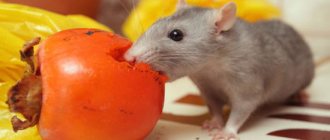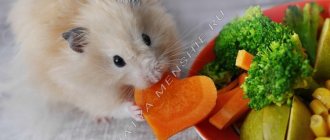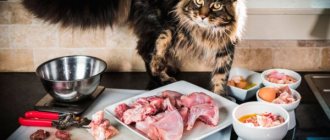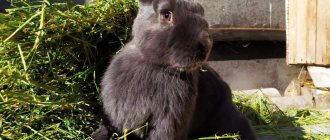Hello friends, in this table we tried to collect the most comprehensive information about what food can be given to a decorative rat and which it is better to abstain from.
If you do not find a particular fruit or vegetable , feel free to ask a question in the comments and we will add it to the table.
By the way, at the top of the table there is a “Search” field, you can enter the word you need and immediately find out whether you can give it to a rat or not - it’s convenient =)
Dairy products in the rat's diet
It is worth noting that despite all the benefits, dairy products can cause serious gastrointestinal disorders in rodents. This is due to a deficiency in rats of the enzyme lactase, which is necessary for digesting the lactose contained in milk. Therefore, you should not give your fluffy dairy products too often, 1-2 times a week is enough. Before the first sample of milk, you need to carefully monitor the animal’s reaction, and if your pet’s health worsens, immediately contact a veterinarian.
Dairy products can and should be included in the diet of a decorative rat. Just to avoid stomach upset, you must follow the dosage. Ratologists advise giving rodents no more than 2-3 g of dairy products at a time.
Cheese
Rats simply love cheese, and if left unchecked, they can eat quite a lot of this dairy product. However, in addition to the invaluable benefits for the body, cheese also poses a health hazard. The product is high in fat and also contains a lot of salt. Therefore, its uncontrolled consumption can lead the rodent to obesity and problems with the cardiovascular system.
The best option for a decorative rat is hard cheese 1-2 times a week. The serving is the size of a fingernail. It is worth noting that it is better not to give your pet soft cheeses, which can stick to the mucous membrane. For example:
- mozzarella;
- feta cheese;
- ricotta;
- blue cheeses;
- Camembert;
- feta
Soft cream cheeses intended for making sandwiches are especially dangerous for rodents. In an unfavorable situation, viscous sticky compounds can stick in the throat, blocking the access of oxygen.
Milk
Animal proteins
Twice, or even three times a week, animals are supposed to receive animal proteins. The following can be served at the table:
- boiled lean meat;
- hard-boiled chicken or quail eggs;
- mealworm, zoophobus (zophobas), gammarus;
- seafood;
- high quality cat or dog dry food.
From poultry, you can give chicken breast, but it is better to feed turkey, which is not fed with growth hormones. From ungulates you can take beef, lean lamb, and game. It is better to grind the boiled yolk with water so that the rat does not choke. You should not feed fatty pork and its derivatives to rats.
Store-bought beef should be soaked for 2-3 hours before cooking, and chicken should be boiled in several waters to remove harmful substances. Rats can suffer from allergies.
What to feed a little rat
A mother rat feeds her offspring with milk. However, there are times when she does not want to do this. In this case, responsibility for the life of the offspring will fall on the shoulders of the animal owner. To feed baby rats, you can purchase a lactating female at a pet store or feed the babies yourself.
To feed babies, you can use a pet milk replacer. Dry soy baby formula diluted with a small amount of goat's milk or condensed milk is also perfect.
Important! Liquid formula can be stored in the refrigerator for no longer than 12 hours.
The milk mixture will need to be warmed up a little. To feed your offspring, it is better to use an insulin syringe with an internal catheter at the tip. You can also take a pacifier made from pieces of cotton fabric.
After each meal, you should pour boiling water over the items. To avoid the development of enteritis in young animals, it is worth giving small rats a course of Biovestin.
Below you can find detailed information regarding the principle of feeding animals by week:
- In the first 7 days of a rodent's life, it is worth feeding them every 120 minutes. liquid diluted milk formula. Closer to the 7th day of life, it is worth diversifying the menu with milk formula, to which a small amount of dry ground grain feed has been added;
- in the second week, the mixture for rodents can be diluted to a consistency that will resemble liquid sour cream. You will need to drink the mixture every 3-4 hours;
- in the third week of life, you can pour the food mixed with the mixture into a bowl. From 23.00 to 6.00 you can not feed the offspring;
- At 4 weeks, animals can be switched to dry food. From the 30th day of life, rodents should be given food that is familiar to adults. If desired, rat pups can be fed milk until the end of the second month of life.
Babies will need to be given formula every 2 hours.
What menu should babies have? When choosing a diet for little rats over 4 weeks old, you should give preference to:
- dry grain;
- boiled chicken, turkey and fish fillets;
- cottage cheese;
- dill and cilantro;
- bananas;
- apples;
- wheat sprouts;
- oats;
- chicken egg yolks;
- boiled chicken and turkey liver.
Under no circumstances should children be allowed to indulge in:
- cucumbers;
- champignons;
- garlic and onions;
- tomatoes.
Note! When rat pups are fed milk by their mother, they can only be fed by the 21st day of life. It is best not to wean babies early from breastfeeding, which has a positive effect on strengthening the animal’s immunity.
Organizing the right diet for your beloved rodent is important; this will allow you to raise the animal healthy. It is important to give up the desire to pamper your four-legged friend with table scraps such as sweets and sausage, as this can provoke the development of various pathologies of internal organs.
Table of permitted and prohibited products
Above are only the main foods that can and cannot be given to a rat. However, the list of permitted and prohibited foods is much wider. For clarity, the main product groups are grouped in the table.
| Category | Can | Rarely | It is forbidden |
| Cereals | Buckwheat, millet, wheat, brown rice, barley, rye, flax seeds | Corn, oats, couscous | Semolina |
| Vegetables | Zucchini, pumpkin, Chinese cabbage | Cucumber, carrots, bell pepper, beets, tomato, broccoli, garlic, onion | Beans, peas, white cabbage, potatoes, radishes, rhubarb, turnips, beans |
| Greenery | Dill, parsley, celery, cilantro, basil, corn salad, arugula, lettuce | Green onions, spinach | Fern, ivy, geranium, lupine, myrtle, tomato leaves |
| Fruits | Apple, cherry, avocado, papaya | Date, persimmon, plum, dried fruits, pomelo, mango, peach, kiwi, melon, pear, pomegranate, cherry, banana, apricot, fig, pineapple | Quince, feijoa, citrus |
| Berries | Irga, gooseberry, | Blueberries, currants, red and chokeberries, raspberries, strawberries, cranberries, hawthorn | Bird cherry |
| Seeds | Watermelon, sunflower, pumpkin, apple | Sesame, any seeds | |
| Nuts | Peanuts, walnuts, pine nuts, cashews, coconut, hazelnuts, almonds, macadamia | ||
| Dairy products | Cottage cheese, Varenets, yogurt without dyes, kefir, fermented baked milk, matsoni, yogurt | Sour cream, cheese, cream, kaymak | |
| Food of animal origin | Poultry, beef, offal, fish, chicken bones | Lamb, seafood, chicken and quail eggs, zofobas, mormysh | Pork, sausages, smoked meats, lard |
| Boiled mushrooms | White, champignon, boletus, boletus |
You can also occasionally pamper your rat with dark chocolate (75-80%), biscuits, baby puree, bread crumbs (homemade, without adding salt or spices).
Every rodent owner should know what can and cannot be given to a rat. After all, only if this condition is met will it be possible to create the right balanced diet for your pet, which will help it grow energetic and healthy. And the most important thing is to please the owner every day.
How to choose food for a rat
When choosing food, you should pay attention to the composition of the mixture. It is advisable that the mixture include:
- Several types of grains;
- Pieces of meat;
- Vegetable and fruit supplements.
This will eliminate the need to purchase additional vitamins. But various flavors and artificial flavoring additives are not welcome here.
The food packaging must be sealed without any signs of moisture. In cardboard packages, an additional sealed insert made of foil or polyethylene is desirable to protect the food from the penetration of insects.
Recommendations: 15 Best Puppy Foods
16 Best Dog Foods
18 best foods
Baits for preparing poison for rats
In order to prepare an effective poison for rats at home (for example, based on Zookoumarin or Krysid), it is advisable to use baits in which the poison can be easily homogenized with the food base.
For example, the following bait bases are good for both rats and mice in this regard:
- Beer, oddly enough, is what rats and mice often cannot resist;
- Milk;
- Meat broth soup;
- Again, raw minced meat, preferably with lard and onions;
- Finely chopped boiled egg;
- Dough with seasonings and spices;
- Boiled porridge, especially with vegetable oil.
Poison is simply added to the food base in the proportions indicated for each drug in the instructions, and the entire mixture is thoroughly mixed. After this, the finished poisoned bait is laid out on a cardboard or saucer (in the case of liquid agents, poured into a plate) and placed where the rats are most likely to quickly find it. All work is carried out wearing rubber gloves.
It is important to take measures to ensure that pets and children cannot reach such bait. This will be discussed in more detail below.
A strong smell is also needed to mask the aroma of poison in the bait. Rats are very suspicious and have a very keen sense of smell. If they suspect the presence of a dangerous impurity in a treat (or a human smell), then they will never touch it. Therefore, the stronger the smell of the food base, the greater the likelihood that the rat will be poisoned.
Is it possible to give cheese to rats?
Is it possible to give pet rats cheese and other dairy products?
The rat is considered an omnivorous rodent; it readily feasts on both plant and animal foods, but not every pet benefits from such nutrition. Domesticated species often have a more delicate digestive system, which often affects the functioning of the entire organism. The article examines in detail the question of whether decorative rats can have milk and why dairy products can have a detrimental effect on their health.
Green food
A caring owner needs to monitor the consumption of greens by a pet rat. List of prohibited green food:
- bugs and horseradish contain substances harmful to animals - essential mustard oils;
- sorrel spinach are a source of oxalic acid, which is dangerous for the pet’s body;
- You can’t feed rhubarb to animals, because it causes disruption of the gastrointestinal tract;
- seaweed has a high iodine content.
Cheese in a rat's diet
Many of us believe that cheese is one of the most favorite foods of rats, and they will never refuse such a treat. There really is some truth in this. They will never refuse aromatic and tasty cheese, but it should act as a delicacy, and not as an ordinary food in the daily diet.
The fact is that cheese is a very fatty product with a lot of salt and cannot be healthy in any way. In large quantities it will lead to obesity and other diseases. It can be given to the animal in very small quantities no more than once a week.
Owners should remember that not all types of cheese can be given to rats; some carry the risk of poisoning and allergic reactions.
The following varieties are prohibited:
- Brynza.
- Suluguni.
- Feta.
- Fused.
- Smoked.
- With mold.
- With increased % fat content.
In the event that an animal has liver disease, kidney disease, or gastrointestinal disorders, it is prohibited to give any types of cheese, as they will cause an aggravation and significantly complicate the situation.
Vegetables and greens
Among vegetables, foods that cause fermentation are prohibited: white and red cabbage, Savoy and Brussels sprouts, as well as cauliflower. Rats can eat broccoli in small quantities. Strong gas formation is caused by radishes, turnips and radishes, as well as all types of legumes: beans, peas, beans and lentils
.
You should be careful when giving sweet peppers; some animals have the same reaction to it. You can sometimes offer boiled green beans if they do not cause gas in your pet. Carrots, zucchini, zucchini and pumpkin are delicious and healthy foods. Cucumbers in excess will cause diarrhea
.
Eggplants are only good when cooked; solanine in raw vegetables can cause poisoning. Artichokes can also only be given cooked. Potatoes will not bring any benefit to the animal
. In its raw form it is contraindicated for animals, but when cooked it acts as ballast. However, some rodents enjoy eating potatoes.
Vegetables, fruits and herbs should be given daily in small quantities - 10-12 g.
Dill, cilantro, parsley, basil and celery are healthy foods for animals and can be given every day. They are not only safe, but also help digest protein foods. Onions, garlic and wild garlic are not suitable due to phytoncides that irritate the gastrointestinal mucosa.
They should be given occasionally and in limited quantities. Acidic vegetables such as tomatoes, rhubarb and sorrel can also eat away at the delicate walls of a rodent's stomach. You should not give animals spinach either. Beets carry another danger - a laxative effect, they should be given carefully. Leaf lettuces that do not have a specific bitterness are generally suitable for animals.
Which is strictly prohibited?
Above we got acquainted with milk, which is allowed to be included in the diet, and below are the types prohibited for consumption:
- Soy. Its use will lead to disorders, gas formation, and bloating.
- Coconut. It is an allergen and in most cases causes the development of severe allergies.
- Condensed. Rodents are prohibited from foods containing sugar; milk also contains a very high sugar content, which will certainly affect their well-being and health.
- Dry. Drinks made from such a product will not bring anything good, but they can cause harm.
Owners of decorative rats need to remember that despite the permits and prohibitions of a particular product, the animal may have allergic reactions to some food or other, and may also have lactose intolerance. New foods should be introduced as carefully as possible. Start with very small portions and be sure to monitor how you feel after that.
Fruit seeds and seeds
One of the prohibited foods is fruit seeds. In particular, the seeds and kernels of citrus fruits contain the toxic substance amygdalin. When it breaks down, hydrocyanic acid is released. One bone contains enough poison to kill the animal. Do not feed your rat seeds and pits of plums, apples, peach, oranges, cherries, lemons and other fruits. Rapeseed and mustard seeds are prohibited for consumption. It is allowed to feed your pets watermelon, sunflower and pumpkin seeds. They are used as a supplement to main food. An overdose of seeds can cause serious poisoning.
Scientists' answer
Scientists from the UK were interested in the question of why mice love cheese. They conducted a number of experiments with mammals.
Experience has shown that mice prefer to eat plant foods, and they do not like the smell of cheese at all. Particularly odorous varieties evoke a feeling of danger, and they try to avoid the suspicious object.
An animal living in the wild will eat cereals and fruits, and will only eat other food in case of severe hunger. In the forest or in the field you will not find products created by man. Therefore, it is not surprising that the mammal loves natural food. It looks and smells safe.
Scientists from the British organization Pest Control UK became interested in the results of their colleagues and conducted their own experiment. They used traps with various baits:
- cheese;
- apple;
- chocolate.
The results showed that mice eat cheese. The trap was set with this delicacy, and they liked to run into it the most. But chocolate did not arouse any interest among the animals.
It is likely that the experiment involved different species of mice and different types of treats, which is why the results are so different from each other.
On a note!
Exterminators assure that you should take sunflower seeds, flour, wheat, and unrefined oil as bait. Pests love this kind of food more.
What should pet rats not eat?
When feeding rodents at home, it is very important to know and select healthy foods. Domestic rodents living in a cage are strictly prohibited from giving fried, baked, pickled, spicy, sweet and salty foods
You should not give hard and moldy cheeses, sausages of all types, homemade lard, raw beans, white cabbage and potatoes. Some pets also like to eat plants. Many housewives in their apartments have plants such as begonia, kalanchoe, geranium, cyclamen; they are poisonous and can cause irreparable harm to the body, so it is better to get rid of these species or move them to a secluded place
Domestic rodents living in a cage are strictly prohibited from giving fried, baked, pickled, spicy, sweet and salty foods. You should not give hard and moldy cheeses, sausages of all types, homemade lard, raw beans, white cabbage and potatoes. Some pets also like to eat plants. Many housewives in their apartments have plants such as begonia, kalanchoe, geranium, cyclamen; they are poisonous and can cause irreparable harm to the body, so it is better to get rid of these species or move them to a secluded place.
What kind of insulation do rats and mice not eat?
The necessary material in a private home is insulation. Modern materials that retain thermal conductivity and reduce energy consumption become objects of eating by rodents. Let's look at examples of insulation materials that are not “appetizing” for these rodents.
Usually they choose foam plastic or mineral wool to furnish their warm nests. Other insulation materials, such as foam glass, expanded clay and liquid wall insulation, do not at all attract them as a culinary value. Foam glass consists of a dense structure made by foaming glass raw materials with a carbon mixture, resulting in the formation of glass cells. Expanded clay has a similar structure, this is enough to prevent rats and mice from getting interested in the delicacy of the insulation.
Source
Are yogurt and sour cream good for rodents?
Yogurt is considered an ideal alternative to kefir; it also contains a whole range of important substances and microflora useful for digestion. In addition, yogurt has a much richer aroma, so its taste is especially acceptable to most pets. At the same time, you must remember that it is not recommended to give foods with various fruit fillings to rats. In most cases, they contain harmful dyes, flavors and flavor enhancers.
Did you know? Rats have been used as pets since about the middle of the 19th century. It was during this period that the legendary London rat catcher Jack Black first carried out decorative selection of rodents, bred breeds that are still popular to this day with white, gray and black colors, as well as fawn shades.
Regarding sour cream, it is strongly not recommended to give such a milk derivative to decorative rodents. The product practically does not contain any vitamins and other substances in sufficient quantities, so it is considered useless for health. With all this, sour cream (and cream) is characterized by high fat content, and such food often leads to various diseases and liver damage in rats.
Store-bought treats
Store-bought treats cause far fewer problems. Because specialized products are made from ingredients that are completely safe for rats. Also on the packaging is all the necessary information - how to store, under what conditions, how much to give to the rat and at what interval. The following store-bought treats are most popular among rat owners:
- Crispy Little One sticks with puffed rice, peanuts and walnuts. The composition also contains wheat, oats, millet, and corn. The delicacy is enriched with a vitamin and mineral complex.
- Multi-colored vegetable and alfalfa balls from JR Farm. The color will tell you what the delicacy is made of. Red balls are from beets, orange are from carrots, green are from alfalfa, yellow are from corn.
- Mealworm ONTO. Rich in protein and fats. Just 1 piece is enough to pamper your pet. Rich in vitamin B12, necessary for normal hematopoiesis. Strengthens the health of the liver, gastrointestinal tract, and also improves immunity.
- Branches of the Kuban apple tree. They have a pleasant taste and aroma. Designed for regular grinding of growing teeth. Other manufacturers offer similar treats for rats (currant, viburnum, willow, birch branches).
- fruit crackers . It is based on a wooden stick and also has a clamp for installation inside the cage. The baked sticks consist of a mixture of cereals, apple and apricot. Contains minerals and vitamins A, D3. Free from artificial colors and flavors. They fill your pet with energy and improve their mood.
- Drops for rodents SANAL. They contain honey and milk, so rat owners are afraid to buy them for their pets. And it’s completely in vain - all ingredients undergo multi-stage purification, during which allergens are completely destroyed. Also contains extracts of fruits and vegetables, vitamins B, C, and minerals (copper, potassium, zinc, manganese).
Many store-bought treats are sold with the general label “for rodents.” Therefore, before purchasing, it is better to make sure that the treat is suitable for rats. The necessary information can be obtained from the seller or on the back of the package.
This is not a complete list of store-bought treats. If desired, you can find other equally tasty and healthy delicacies for decorative rats in pet stores.
A little history
Who knows where this myth came from. Most likely, the traces lead to the Middle Ages. Before the invention of the refrigerator, storing food was much more difficult, so everyone got out of the situation as best they could: meat was attached to a hook under the ceiling, grain was kept in bags or barrels, and large circles of cheese were covered with wax or wrapped in linen. In those days, a hungry mouse agreed to eat anything. Meat hanging from the ceiling was harder to get, wheat or cheese was much easier to access. But the loss of several grains from the bag is not so noticeable, and teeth marks are treacherously visible on a piece of cheese. This may have led many to believe that mice love cheese. Even if in fact they only eat it because it turned out to be their only prey.
What to consider?
Although bread is not harmful to rats, you must be careful not to overfeed your rat. Bread is quite high in calories, so it is very easy to overfeed a rat with it.
If you are going to feed your pet rat bread, you should only give them a very small amount of bread on special occasions. Rats are small animals, and although a piece of bread may not seem like much to you, to a rat it is a huge amount of food. You should also make sure you don't put any oil on it before you give it to them. Butter is high in calories and will turn the already high calorie treat you are about to give them into an even bigger calorie bomb.
Quality grapes - what are they?
Many owners are very mistaken in believing that a decorative rat should and can eat absolutely everything. Including products that are far from fresh. When choosing grapes, you need to focus on fresh bunches. Rotten berries will bring neither benefit nor pleasure to a rodent. When choosing grapes, pay attention to their appearance.
The best solution is to provide grapes grown in environmentally friendly conditions and without chemical treatment. Such berries can be collected at your summer cottage or bought from a small farmer at the market.
If wasps are constantly flying around a stand with grapes, this is an indication that it has not been treated with harmful chemicals. You can safely buy such berries. If you purchased them in a store, then before giving them to your pet, pour boiling water over them several times.
What living conditions are required for decorative rats?
It is best to place the rat in a spacious wire cage Caring for your rat. Height - no less than 50 cm, minimum floor area - 50 × 80 cm. The flooring must be hard and even, for example plastic. The option with rods will not work: the animal may damage its paws.
Photo: borisenkoket/Shutterstock
There are several rules for placing a house. Rodents are susceptible to cold and heat. They feel best at a temperature of 20 degrees. Therefore, the cage is usually placed away from direct sunlight, radiators and drafts. If there are other animals in the house, then the home should be, for example, on the Rat: Species Profile nightstand or table.
A nipple drinker and bowls must be placed inside the cage. If desired, you can buy a tray and filler for rodents. The rat should also have a shelter: a hammock or a house.
Photo: Bilanol/Shutterstock
Rodents love toys very much. For entertainment, owners choose running wheels, tunnels, platforms and wooden figures. The latter should be changed regularly, otherwise the animal will get bored.
Rats like to make nests. Therefore, you can periodically put paper in the cage. Remember that newspaper sheets will not work. The ink can cause poisoning to your pet.
Which bread is better for a rat: white or whole grain?
The main difference between white and whole grain bread is that the white variety is made from refined grains. Cleaned grains go through a process where they remove certain parts of the grain. Due to this process, quite a lot of fiber and some nutrients are lost.
Whole wheat flour contains much more manganese, selenium and fiber. It's also lower in sodium, which is good because rats don't need much sodium in their diet, and commercial diets already contain more sodium than they need.
For these reasons, it is much better to feed your rat whole grain bread rather than white bread.
The most effective traps
Several of the most effective methods are used to control pests. These are poisonous baits, ultrasonic repellers, mousetraps that kill or catch animals alive, and sticky traps.
Each method has its own characteristics, advantages and disadvantages. To choose the appropriate option, you should consider them in more detail.
Poison traps
Placed in places closest to nests or movement routes of animals. Often made from seeds or grains. Rodenticides can be purchased at pharmacies.
The drugs are made on the basis of substances that block blood clotting. As a result, rodents die from internal bleeding. Such baits should not be used in areas where pets live.
Ultrasonic repellers
This method is considered the most humane and safe for both animals and humans. Such devices produce sounds at a certain frequency.
For humans they are imperceptible, but for rats they are simply unbearable . Some models, in addition to ultrasound, are capable of emitting special sound signals and scaring away beepers using light flashes.
The combination of several effects completely kills the desire of pests to be near such powerful stimuli. In the first few days of using repellers, an increase in the number of rats may be observed, but do not be alarmed, this is a normal reaction.
Ultrasound causes real panic in pasyuki, forcing them to be active during the daytime and chaotic movements around the house. In a couple of weeks the room will be completely cleared of parasites.
Another safe and humane way to control rodents is with essential oils. Animals simply cannot stand the smell of mint and try to stay away from it.
Rat traps
If there are a lot of pests, you can try to catch them with a rat trap. To do this, you need to use the best baits that were listed above.
When setting traps, it is important to ensure that there are no small children or pets nearby.
Compared to poisons, mousetraps have undeniable advantages . A poisoned rat can die anywhere in the house. The corpse under the floor will poison the air with an unpleasant odor for a long time.
Traps with bait for rats are located along the walls, in areas where rodents or traces of their presence have been noticed. Typically traps are placed perpendicular to the wall.
In addition to devices that kill animals, there are also so-called “live traps”. They confine the animal without injuring it. This allows you to release the rat into the wild, the main thing is to do it away from your home.
Sticky traps
Usually used for catching mice, since their weight is much less than that of a rat. The animal, running along its usual routes, ends up on a sticky surface from which it cannot get out.
If such a trap is glued to the body of a person or pet, it can be removed using vegetable oil.
The installed traps are checked every day. All manipulations must be carried out with rubber gloves.











